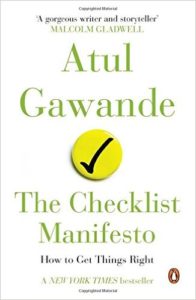In Search of Checklistables*
What is your big goal? Is it scary? Do you think you can do it?
My big goal is to help 10,000 people start online businesses based around what they love. That’s a big goal. I’d need to be a different person to pull that off. I’d need to be far more disciplined, I’d need to hire a few people. Do things I have not done before. That’s a scary proposition.
I also want to help my daughter read Arabic.
Some problems are harder than others.
Understanding the problem is half the solution. This is a cliche, meaning that we tend to gloss over it and not pay attention to it. And also as most cliches, this is absolutely accurate.
We need to better understand problems, agreed?
What we need to do, is to train ourselves to see each problem as a challenge to surmount, as an invitation to up our game. The problem becomes the invitation, the fear becomes the guide and the obstacle becomes the way.
The 3 types of Problems
There are people out there who have done this categorization for us to use, notably Dr Brenda Zimmerman and Sholom Glouberman. In their framework, there are Simple problems, Complicated problems and then there are Complex problems.
Simple Problems have solutions that are inherently ordered. Baking a cake is a classic example of such a problem. There is a step by step method that can be followed, and in the end, you will have the desired result: a beautiful and tasty cake for me to sell on cakes.pk. 🙂
Any problem that can be solved using a replicatable number of steps, that is a Simple problem. Lets call them Checklistable problems.
Complicated Problems are problems like building a standard house in a large residential area. A large number of skill sets need to come together. Although many big problems can be broken down into smaller checklistable types, the overall Problem is too Complicated to have an exact step by step. These problems typically involves different teams needing to work together in a coordinated fashion. Complicated indeed.
Then there are Complex Problems. The perfect example here, as given by Dr Brenda Zimmerman and used by Dr Atul Gawande in his book The Checklist Manifesto as well, is that of raising a child. Raising a child is a Complex problem.
You may have a lot of variables and varying systems that influence the successful raising of a child… that may make one think that it’s a Complicated system. But each child is different. That makes the whole system more complex. You can’t really, as an attentive parent, expect to raise your second just like you raised your first for example. As Dr Atul says in his book, Expertise is valuable but most certainly not sufficient.
So that’s the framework for looking at problems.
Now we add the tool to navigate this framework: the checklist.
Checklists
The suggestion offered by Atul Gawande is deceptively simple: solve complex problems using the power of the checklist.
The unassuming checklist is shown to help us achieve seemingly insurmountable goals. In his book, The Checklist Manifesto, Atul Gawande makes the case that complex problems can be better handled with checklists.
The case is made with riveting stories from hospital emergency rooms, construction sites of large skyscrapers, responding to hurricanes and businesses of all sorts.
I have certainly found new respect for the checklist. How?
- You see, this idea of focusing on checklists becomes that small activity that produces big results. It is that 20% that can produce 80% of the results. And that makes the checklist an integral part of the Mighty Protocol of Superior Beings.
- A simple slap on an over-complicated face! Checklists are cool because they are simple, and a slap in my face when I over-complicate something that are Checklistables. Note to self: stop over-complicating the Checklistables.
How can you use Checklists?
We already use them. Now perhaps we can be more deliberate about thinking in terms of checklists.
- I have for example structured most courses in the ProHobbyist Membership along these lines: break down Complicated problems into Simpler ones, and then make a Checklist for the students to go through the actions.
- A lot of business world is filled with systems, and many systems are basically checklists. Want to create a website? There is a checklist for that. Want to run a Facebook campaign? A checklist for that too.
- Want to launch an online product? There are a lot moving parts, but they can be put together by following a checklist.

Disciplined Creativity
The fresh take on checklists gives me a very convenient framework for tackling any problem out there: I start by thinking,
“Which parts of this problem can I make a checklist of?”
“Which parts are checklistable?”
“Will this checklist?”
To really solve problems, it comes down to:
- the accuracy of the checklist (How good is the checklist), and,
- the care with which it is followed (How diligently is the checklist followed).
Both of these are not easy but none of the good stuff is.
If anything, finding Checklistables is a good place to start tackling problems of all sizes, from the small ones to the ones you thought about at the start of this article.
+++
Further Reading / Resources
 The Checklist Manifesto: How to Get Things Right by Atul Gawande. Highly recommended, as there is more to the deceptively simple “checklists”.
The Checklist Manifesto: How to Get Things Right by Atul Gawande. Highly recommended, as there is more to the deceptively simple “checklists”.
- You can buy from Amazon at this link.
- If you are in Pakistan, the good folks at LibertyBooks have it available at this link (you can order online, cash on delivery).
+++
Dr Brenda Zimmerman’s seminar on managing complexity was my primer into the study of complexity. YouTube has a wealth of knowledge on managing complexity (surprise surprise).
If you don’t have time to see the whole seminar, check out this part from the seminar:
How to organize a children’s birthday party, based on the nature of systems. (The dry humor takes a bit of getting used to)
Watching the whole seminar by Dr Brenda Zimmerman is recommended.
+++
*yes, it’s not a word, I made it up. I like it. And yes, you can use it too.



